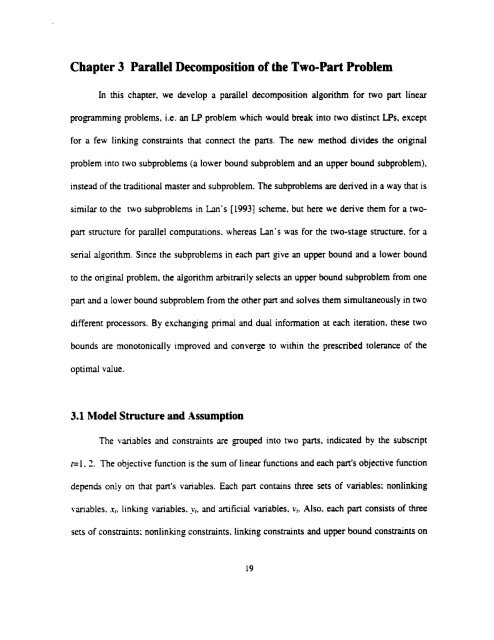X - UWSpace - University of Waterloo
X - UWSpace - University of Waterloo
X - UWSpace - University of Waterloo
Create successful ePaper yourself
Turn your PDF publications into a flip-book with our unique Google optimized e-Paper software.
Chapter 3 Paralle1 Decomposition <strong>of</strong> the Two-Part Problem<br />
In this chapter. we develop a parallel decomposition aigorithm for NO part linear<br />
programrmng problems, Le. an LP problem which would break into two distinct LPs. except<br />
for a few linking constraints that connect the pans. The new method divides the original<br />
problem into two subproblerns (a lower bound subproblem and an upper bound subproblem).<br />
instead <strong>of</strong> the traditional master and subproblem. The subproblems are derived in a way that is<br />
similar to the two subproblems in Lm's il9931 scheme. but here we derive them for a two-<br />
pan structure for pyallel computations. whereas Lm's was for the two-stage structure. for a<br />
senal algorithm. Since the subproblems in each part give an upper bound and a lower bound<br />
to the original problem. the algorithm arbiuarily selects an upper bound subproblem from one<br />
part and a lower bound subproblern from the other part and solves them simultaneously in two<br />
diffe~nt processon. By exchanging prima1 and dual information st each itention. these two<br />
bounds are monotonically improved and converge to within the prescribed tolerance <strong>of</strong> the<br />
optimal value.<br />
3.1 Mode1 Structure and Assumption<br />
The variables and constnints are grouped into two parts. indicated by the subscnpt<br />
r=l. 2. The objective function is the sum <strong>of</strong> linem functions and each part's objective function<br />
depends only on that pan's variables. Each part contains three sets <strong>of</strong> variables; nonlinking<br />
variables. .r,. linhng variables. y, and artificial variables. v~. Also. each part consists <strong>of</strong> three<br />
sets <strong>of</strong> consuaints: nonlinking constraints. linking consvaints and upper bound constraints on
















